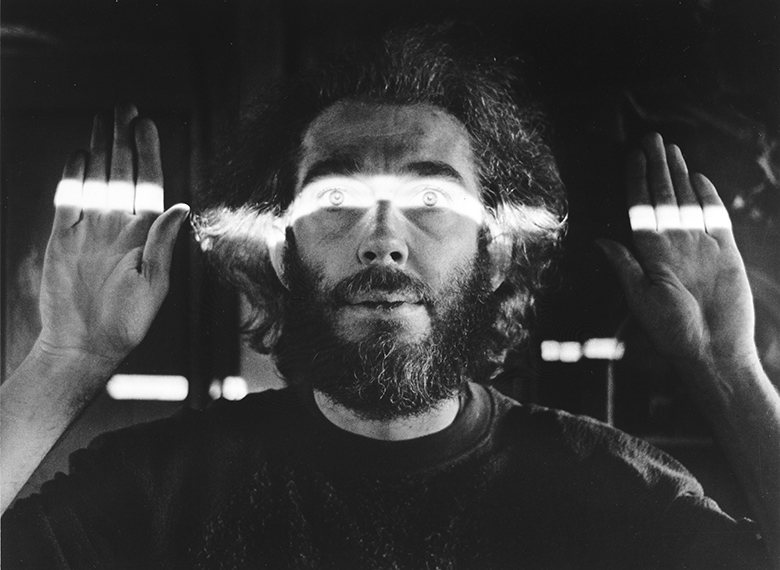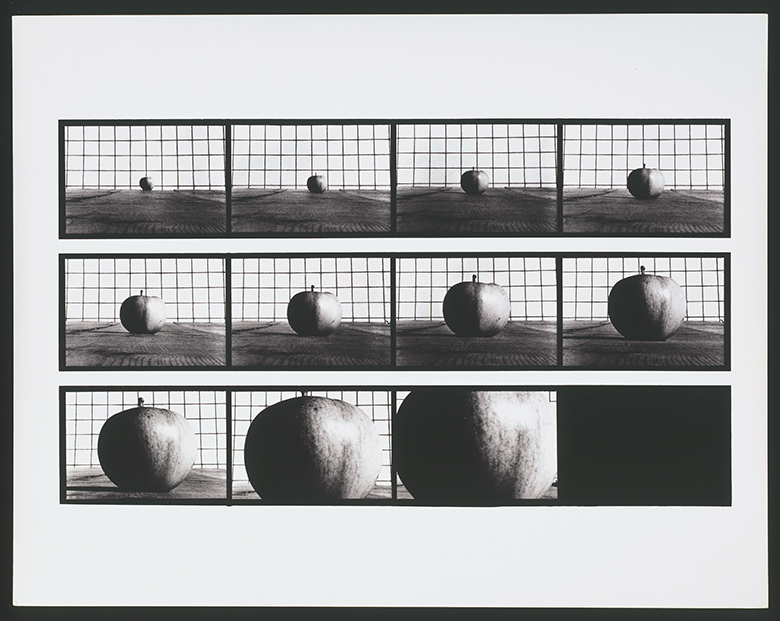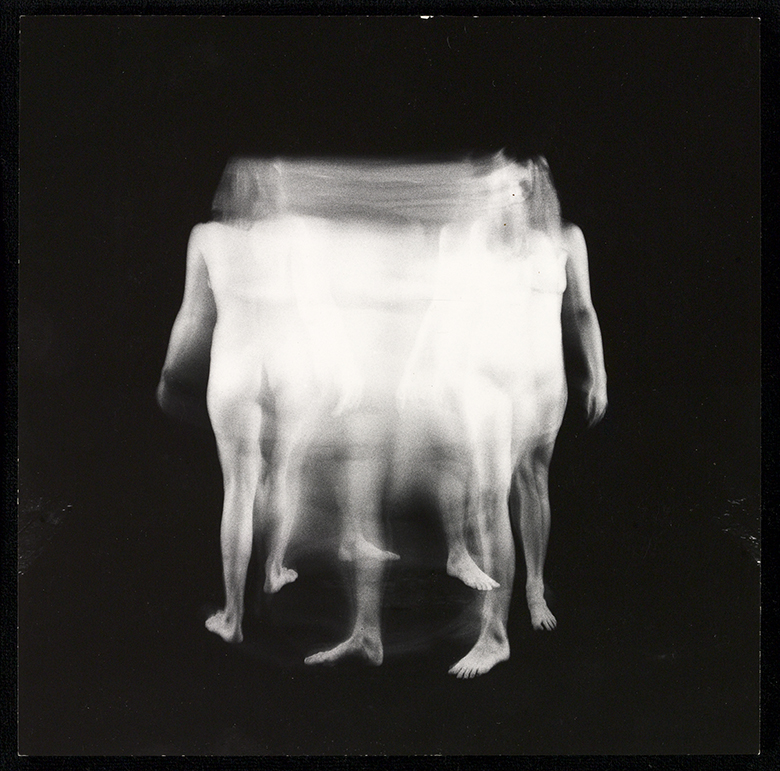One fine morning, I awoke to discover that, during the night, I had learned to understand the language of birds. I have listened to them ever since. They say: “Look at me!” or: “Get out of here!” or: “Let’s Fuck!” or: “Help!” or: “Hurrah!” or: “I found a worm!” and that’s all they say. And that, when you boil it down, is all we say. (Which one of those things am I saying now?)
—Hollis Frampton, “A Pentagram for Conjuring the Narrative”1
He was, by all accounts, an astounding polymath of a man. Passing him on the street, however, you might have mistaken him for a drifter: his teeth were rotten, his hair was rarely combed or even washed, and he wore a perennially soiled denim jacket for almost every public appearance in the last decade of his life. Born in the small town of Wooster, Ohio in 1936, Hollis Frampton grew up to become that erratic and often lamentable kind of genius who completely eschewed his physical form for the pursuit of his intellectual passions. The uninitiated should not let this outward projection fool them though—Frampton was not playing the cynical, junky, capital “A” American iconoclast in the mode of many of his literary and filmic contemporaries. He was more in the Joycean vein of the absolutely unremitting artist, the ever-obsessive theorist, drawing parallels and crossovers between all choirs of the mind. What did he do? A lot, even in his short life.
Early on in his artistic career, Frampton had the opportunity of a century—he studied under Ezra Pound. This didn’t take place in any university however, as Pound never taught at one and Frampton had just declined to take a full scholarship to Harvard. The year was 1957, and Pound lived in St. Elizabeth’s Mental Hospital. As Pound was nearing his seventy-third birthday, his last year in the bug house, the young, fresh-faced, and not yet soiled denim-jacket-wearing Frampton would visit him and undergo his poetic guidance. This tutelage didn’t have the desired effect in the end, at all. By his admission Frampton was an awful poet, and nothing Pound could do could change that. Poetry didn’t stick.
However, what the impressionable twenty-two year-old Frampton no doubt witnessed was the modern master’s slow decline into dementia, senility, and eventual muteness. Pound would have several important impacts on the young man, the deepest of which was the realization that the progenitor of modern poetics had failed, and in many ways was doomed to fail, in his most ambitious, sprawling, and fully narrative work, The Cantos, which Pound wrote during his confinement.
It was possibly this long and direct exposure to the abject genius, lunacy and failure of Pound that inculcated within Frampton a desire to expand the boundaries of what art could accomplish. Seeing the catastrophe of The Cantos and the depression and aimlessness of Pound’s lifeleft a power vacuum in the young Frampton’s mind: if this could happen to this master, this absolute monolith of the 20th century avant-garde, what could happen to the rest of us? And if modern poetics had failed, what was left for fine art? What was left for film? Would we all end up writing incredibly dense, epic poetry in an asylum?
Most failed poets don’t ever amount to much—they move back home and start a family, get a few day jobs or maybe start up a jazz band, but that wouldn’t happen to Frampton. The modernist cries of “make it new” were now long gone. Frampton would make “it” even newer. He packed his few belongings into a 1950 Studebaker and moved to New York.
Frampton got to work. He already knew Latin and Sanskrit, was fluent in Greek, Russian, French, Chinese, but he endeavored to refine his German so as to complete his translation of a seven-volume anthropological text by Leo Frobenius. Frampton did this, but then never published the translation. During this time, his early twenties, and holding no degree, he worked as a framer in a print shop, an electrician, and lived under Carl Andre’s stairs. In ’58, he bought a Nikon for Christmas and started taking pictures. In ’62 he borrowed a Bolex and started some tentative experiments in film2. His artistic output for the next thirty years would be as astounding as it was multi-disciplinary.
He would discover his interest in abstract expressionist painting, only to abandon that once he realized he simply didn’t like smearing goo around on a canvas. He would become a ceaseless defender of the archaic still photograph, all while pioneering and eventually programming languages for early voice synthesizer software. He would half-jokingly develop a mathematical algorithm meant to determine the precise amount of suffering undergone by each person in the history of the world. He would philosophize about the purpose of narrative in art. He would attempt a massive, thirty-six hour meta-historical film about Magellan’s circumnavigation of the globe. He would predict, forty years hence, the widespread use and proliferation of digital imaging technology as a means of global communication. He would loudly bemoan the gulf between science and art and work to bridge the two. He would produce a film comprised entirely of a single point perspective shot of a lemon.
But for all (or perhaps because of) its genius, Frampton’s work could be hard to sit through, especially in a public theatre setting. Somewhat like how the best avant-garde music today is rarely experienced properly by seeing the musician perform it live at a bar, crowds of unsuspecting film goers were often incensed by Frampton’s offerings. In 1973, after the screening of three Frampton films, during which the audience was understandably a little flustered, a woman asked the filmmaker if he thought his films communicated to an audience. Frampton responded in his usual prescient manner:
If you mean, do I think I communicated to those in the audience who tramped indignantly out of my films, the answer is no, but I think there is a problem with your idea of communication. You seem to work on the assumption that you have this hole and I have this thing, and you want me to put my thing in your hole and that will be “communication.” My idea of communication is very different. It involves my trying to say something I think is important and into which I have put all my thought and substantial labor. Necessarily, what I have to say will be difficult to apprehend, if it is original enough to be worth saying at all. That is my half of the communicative process. Yours must be to sensitize and educate yourself fully enough to be able to understand. It is only when two people—filmmaker and viewer in this case—can meet as equals that true communication can take place.3
In his most “famous” film, (nostalgia), Frampton slowly and methodically puts his earlier work, beautifully rendered still photography, over top a stove and incinerates each picture in a single shot. While he does this, a narrator recalls in painstaking detail the circumstances and situations by which the work was initially conceived, produced, and exhibited. But Frampton's trick in this film is that his narration is out of synch with the image being incinerated. As we inspect each photograph, we have to strain to recall its story while a new story is being told. This lag between what is being burned and what is being described has a disorienting effect—disturbs the viewer's logic, mildly brainwashed to be straightforward picture-word association. Before the fires of the third still, which burn a portrait of Frampton as a young, studious-looking man, the narrator says:
This face is my own, or was once my own. One exposure records what now looks to me like a leer. I sent that one to a very pretty and sensible girl on the occasion of the vernal equinox, a holiday I held in some esteem. I think I wrote her some kind of cryptic note on the back of it. I never heard from her again.4
Between each pyre, the single shot churns along with the full noise of the smoke in the background, until the shrinking black ashes eventually blow away or turn to nothing.
Frampton had a fraught relationship with the parts of the world that wanted him to be the person he was in the photograph in (nostalgia): the bookish, buttoned-down “leering” intellectual, completely dedicated to the established boundaries of art and time. The person he turned out to be, vigorous and fanatical, fueled only by the pursuit of a singular and incessant expressive vision and an apocalyptic craving for nicotine, is the one that paces back and forth inside us all.
During his last major interview, the legendary “Chicago Interview” in 1978, a visibly ailing Frampton smokes fifteen cigarettes in a little over half an hour, a feat compounded by the fact that he smokes only filterless pouch tobacco.5 With thirty cigarettes an hour, even if Frampton is awake for only ten hours a day, the odds of him surviving very long on this free flowing tar-diet aren’t good. Hollis Frampton died in 1984, somewhat redundantly, of lung cancer. He left many of his lifelong projects unfinished, but the ones he completed still push the boundaries of the film avant-garde decades later.
It is worth remembering that a genius like Frampton could have just simply been one thing. Since he died, the world has become a much different place, but we’re living, in many ways, in Frampton’s future: the future where no one can be one thing, where no artist can ignore disciplines they didn’t study in art school, where every schoolchild also needs to know how to design a website. We all have to be polymaths now, whether we like it or not. Frampton’s disbelief in the isolation of fields of study, the expatriation of the serious poet, has become a standard disbelief in the modern multi-disciplinary artist. As a meditation on what is to come in our future, we need to look to the Hollis Framptons of our generation. Where will they come from? In his style, they will likely not come just from the academy or the art gallery, but also from the bird sanctuary, from the fringes of the avant-garde. I can’t predict who or where this will be, but if I’ve learned anything from Hollis it’s that I should probably stop writing poetry.





